Abstract
In recent years, there has been extensive research into the development of cheaper and more sustainable carbon fiber (CF) precursors, and air-gap-spun cellulose-lignin precursors have gained considerable attention where ionic liquids have been used for the co-dissolution of cellulose and lignin. However, ionic liquids are expensive and difficult to recycle. In the present work, an aqueous solvent system, cold alkali, was used to prepare cellulose-lignin CF precursors by wet spinning solutions containing co-dissolved dissolving-grade kraft pulp and softwood kraft lignin. Precursors containing up to 30 wt% lignin were successfully spun using two different coagulation bath compositions, where one of them introduced a flame retardant into the precursor to increase the CF conversion yield. The precursors were converted to CFs via batchwise and continuous conversion. The precursor and conversion conditions had a significant effect on the conversion yield (12–44 wt%), the Young’s modulus (33–77 GPa), and the tensile strength (0.48–1.17 GPa), while the precursor morphology was preserved. Structural characterization of the precursors and CFs showed that a more oriented and crystalline precursor gave a more ordered CF structure with higher tensile properties. The continuous conversion trials highlighted the importance of tension control to increase the mechanical properties of the CFs.
1. Introduction
Carbon fibers (CFs) are produced by thermal conversion of a carbon-rich organic precursor at high temperatures, whereby the carbon content is increased to at least 90 wt% [1]. CFs have a remarkably high stiffness- and strength-to-weight ratio, making them an ideal component in lightweight composites. CFs are currently mainly used in wind turbine blades, aerospace industries, sporting goods, and luxury cars [2,3]. The global demand for CFs is expected to increase in the future, and a greater utilization of CFs in the mainstream automotive sector is desirable [4]. However, a wider use is inhibited by the high CF price, which is due to the use of expensive fossil-based precursors and an energy-intensive manufacturing process.
Attention has been drawn to cellulose and lignin, as they are renewable macromolecules and are readily available in large quantities from the kraft pulping process [5,6]. The most favorable characteristics of cellulose and lignin for CFs are their molecular orientation and high carbon content, respectively. Already in the 1960s and 1970s, cellulose was used to produce commercial CFs by the thermal conversion of regenerated cellulose fibers (viscose rayon). After hot stretch graphitization above 2000 °C, these cellulose-based CFs (Thornel series by Union Carbide) had a high Young’s modulus (~500 GPa) and tensile strength (~2.6 GPa) [7]. However, cellulose generally gave a low conversion yield of 10–30 wt%, which originated from its low carbon content (44.4 wt%) [2,8].
The low yield, in combination with the expensive hot stretch graphitization process, led in the 1970s to the use of polyacrylonitrile (PAN, yield ~50 wt%) instead of cellulose as a CF precursor [7]. At present, more than 96% of all commercial CFs are made from petroleum-based PAN, where the PAN precursor accounts for about half of the total CF production cost, which explains the urgent demand of finding more sustainable and cost-competitive CF precursors [3,9]. Since the early 2000s, extensive research has been devoted to finding a cheaper and more sustainable alternative to PAN.
The melt spinning of different types of lignin to CF precursors have been investigated [5,10,11,12,13,14,15]. Kraft lignin is available from kraft pulp mills and has a high carbon content (60–65 wt%). Unfortunately, it is challenging to make CFs from melt-spun lignin precursors, as these precursors are brittle (hard to handle) and generally require a very long stabilization time (up to 100 h), making industrial production unfeasible [13]. The problem is that a melt-spinnable lignin is difficult to stabilize in a realistic period of time. Softwood kraft lignin has a more crosslinked structure than hardwood kraft lignin, but it contains only a small fraction suitable for melt spinning [14,15]. Hardwood kraft lignin is easier to melt spin, but it has a low thermal reactivity, leading to a long stabilization time [10,11]. In addition, the importance of having suitable thermal properties for successful melt spinning often necessitates the use of a fractionation process such as membrane filtration or solvent extraction of the lignin, which elevates the cost of the raw material [11,16].
Due to the difficulties in processing either cellulose and lignin to CF alone, the use of a precursor based on a blend of cellulose and lignin has been proposed in order to combine the advantages of each polymer, i.e., the molecular orientation of cellulose and the high carbon content of lignin. It has been shown that ionic liquids are capable of co-dissolving cellulose and lignin at high pulp viscosities and high lignin loads (up to 70 wt% relative to cellulose) into solutions that can be spun via air gap spinning to yield oriented CF precursors [17,18,19,20,21]. The use of a solution spinning technique such as air gap spinning is advantageous because it allows the use of, for example, softwood kraft lignin, and this has led to a substantial reduction in stabilization time (<2 h) [22,23,24]. Additional benefits of using cellulose-lignin bicomponent precursors are the precursor strength and the substantial increase in yield after conversion compared with the use of a pure cellulose precursor [19]. Ionic liquids that are capable of co-dissolving cellulose and lignin are, however, expensive and difficult to recycle, so their industrial viability is still unclear [25]. It is therefore desirable to find an alternative solvent system, preferably water-based, capable of co-dissolving cellulose and lignin.
In the present work, the main objective was to use an aqueous solvent system instead of an ionic liquid to co-dissolve cellulose and softwood kraft lignin to prepare CF precursors. Aqueous NaOH at a low temperature (<0 °C, “cold NaOH(aq)”) was used to co-dissolve cellulose and lignin into a spinnable solution, which were wet spun to CF precursors using two different coagulation bath compositions. The cold NaOH(aq) solvent system is potentially a cheaper and greener route than the use of ionic liquids to prepare lignin-cellulose CF precursors. To the best of our knowledge, this is the first scientific report demonstrating the possibility of spinning cellulose-lignin CF precursors via a cold NaOH(aq) solvent system. The precursors were subsequently converted to bio-based CFs using both batchwise and continuous conversion. The effects of lignin content and coagulation bath composition on the properties of the precursor and of the resulting CFs were investigated.
2. Materials and Methods
2.1. Materials
The cellulose source used was a pre-hydrolyzed softwood kraft pulp (spruce/pine) of dissolving grade. After cooking, the pulp was oxygen-delignified, followed by bleaching with ozone and bleaching with chlorine dioxide in two stages. This resulted in a pulp with an intrinsic viscosity of 260 mL/g. This was similar to what has been reported in earlier work on regenerated cellulose fibers from the cold NaOH(aq) process [26,27]. Further information regarding the cellulose pulp and its preparation was given by Brännvall and Walter [28].
The lignin used was a softwood kraft lignin produced by the LignoBoost process at LignoDemo in Bäckhammar, Sweden, containing 1.2 wt% carbohydrates, 94 wt% Klason lignin, and 6.3 wt% acid-soluble lignin. The elemental composition was 64 wt% C, 25 wt% O, 1.4 wt% S, 5.4 wt% H, and 0.11 wt% N. The ash content was below 1 wt%. A full summary of the lignin characteristics can be found in the work by Bengtsson et al. [19].
Zinc oxide (ZnO, >99.9 wt%) was purchased from Alfa Aesar (Germany), and sodium hydroxide (NaOH, >99.0 wt%), sulphuric acid (H2SO4, 95–97 wt%), and sodium sulfate (Na2SO4, >99.0 wt%) were purchased from Merck (Germany). Orthophosphoric acid (H3PO4, 85 wt%) and ammonium dihydrogen phosphate (NH4H2PO4 (ADHP), ≥97.5 wt%) were purchased from WVR International AB. A fabric conditioner (Neutral®, Unilever, Denmark) was used as spin finish.
2.2. Preparation of Spin Dopes
Prior to dissolution, the cellulose pulp was swollen in 5 wt% NaOH(aq) at a consistency of 10 wt% for 12 h at 4 °C. The swollen pulp was then transferred to a vertical kneader equipped with a cooling system (Huber Kältemaschinenbau AG). Deionized water, ZnO, and NaOH were added, adjusting the dope concentrations to 4.5–5.5 wt% cellulose, 8 wt% NaOH(aq), and 1.5 wt% ZnO, and the cellulose was dissolved by mixing for a total of 32 min according to the following: (1) −10 °C for 8 min, (2) −5 °C for 12 min, and (3) −0.5 °C for 12 min. Complete dissolution was confirmed by inspection of the dope under a light microscope (Axioscope 50, Zeiss AG). The cellulose solution (dope) was filtered with a Nutsch filter type 3 (Büchi AG) over a 70 µm sintered filter, and the dope was then deaerated in a high-speed brushless centrifuge (MPW-350, MPW Med. Instruments) at 5000 rpm for 15 min.
Lignin was added to the cellulose dope under stirring. Because cellulose is the fiber-forming polymer, the cellulose concentration was held constant at 4.5 or 5.5 wt%, while the amount of added lignin varied depending on the desired cellulose:lignin ratio. After the addition of lignin, the dope was again filtered over a 32 µm sintered filter followed by a final dope deaeration at reduced pressure (3.5 kPa) for 3 h. Prior to spinning, the dopes were stored at 4 °C.
2.3. Wet Spinning
The spin dopes were transferred to a modified bench-scale wet spinning equipment (Dissol Co. Ltd., Jeonju, Republic of Korea) and spun into precursors, as shown in Figure 1. The spinning equipment consisted of a dope tank, a gear pump, a coagulation bath, four wash baths, a spin finish applicator, a drying cylinder, and a winding system.
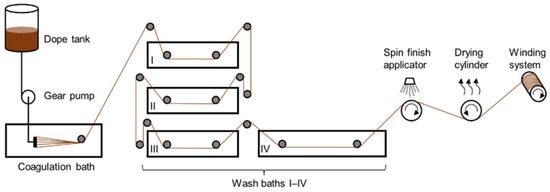
Figure 1.
Schematic of the wet spinning equipment used for precursor spinning.
Precursors were prepared using two coagulation baths: Systems S (H2SO4/Na2SO4) and System P (H3PO4/NH4H2PO4). Table 1 presents a summary of the conditions used for spinning with each system. In both cases, the diameter of the spinneret holes was 100 µm and the extrusion speed was set at 1.3 m/min, while the take-up speed was 3.2 m/min, giving a stretch ratio of 2.5. The temperature in the coagulation and wash baths was 20 °C. In both systems, a drying temperature of 85 °C was used, and the wash time was adjusted by changing the wash sequence setup and the distance between the godets in the baths. The spin finish (1 wt%) was applied either in bath IV or by a separate spin finish applicator.

Table 1.
Details of the wet spinning of precursors with Systems S and P.
After spinning, the precursors were stored on bobbins at 23 °C, 30% RH for at least 48 h prior to characterization. Precursors with up to 30% added lignin were spun (Table 2). The difference in titer was due to a variation in spinneret clogging.

Table 2.
Summary of the precursors produced.
2.4. Stabilization and Carbonization
2.4.1. Batchwise Conversion
The precursors were fixed on graphite frames (Gerken Nordiska Karma, Sweden) to prevent shrinkage during the thermal conversion to CF. The fixed fibers were stabilized batchwise in a KSL-1200X muffle furnace (MTI Corporation, USA) using air (7 L/min) by heating at 1 °C/min from 25 to 250 °C followed by an isothermal period of 60 min at 250 °C, giving a stabilization time of 285 min. The stabilized precursors were then carbonized in a nitrogen atmosphere (200 mL/min) using a Model ETF 70/18 tube furnace (Entech, Sweden) by heating at 3 °C/min from 25 to 1000 °C, giving a carbonization time of 325 min. The precursors spun with System P were converted batchwise to CF using the same equipment, but in this case, the fibers were stabilized by heating at 5 °C/min from 25 to 250 °C followed by an isothermal period of 5 min and a subsequent ramp to 260 and then to 275 °C using the same heating rate (5 °C/min) and isothermal period (5 min) at each temperature. This gave a total stabilization time of 65 min. The final carbonization temperature for the System P fibers was 1100 °C, giving a carbonization time of 358 min.
2.4.2. Continuous Conversion
The precursors from System P were continuously converted (endless stabilization and carbonization) with a setup described in detail elsewhere [29]. In short, the setup consisted of a winding system and a horizontal tube furnace (heated length 0.6 m). The speed of the winding system was changed to alter the residence time in the furnace. A yarn tensiometer (ETX Solo, Eltex AB, Osby, Sweden) was used to monitor the fiber tension, and the tension could be altered by changing the relative speeds of the unwinder and winder. In these experiments, the precursors were continuously stabilized for 15 min in an air atmosphere using inlet and outlet temperatures of 250 and 275 °C, respectively. The tension applied during continuous stabilization was low (0.2–0.3 cN/tex), and the relative stretch was −1% (fiber contraction). Continuous carbonization was carried out in nitrogen at 1100 °C at various fiber tensions (0.2–1.3 cN/tex) corresponding to a relative stretch between −8% and −4%. For fiber tensions up to 1.0 cN/tex, a residence time of 10 min was used, but when a tension of 1.3 cN/tex was applied, the residence time was 20 min.
2.5. Characterization
The morphology of the precursors and of the CFs was evaluated in an SU3500 electron microscope (Hitachi, Japan) at an acceleration voltage of 3 kV using a secondary electron (SE) detector. Prior to imaging, the fibers were sputtered with gold. Cross-sections of precursors were prepared by cutting the fibers with a scalpel in liquid nitrogen or using tensile fracture surfaces while CFs were cut at room temperature.
Single fiber tensile tests were performed on a LEX820/LDS0200 (Dia-Stron Ltd., UK) equipped with a laser diffraction system for diameter determination (CERSA-MCI, France). The precursors and CFs were tested at 21 ± 2 °C and 31 ± 2% RH using a fixed gauge length of 20 mm at elongation speeds of 5 mm/min and 0.6 mm/min, respectively. The data were evaluated with the UvWin software (Dia-stron Ltd., UK). The reported values are averages of 20 and 30–40 individual filament measurements for precursors and CFs, respectively.
The gravimetric yield of the batchwise-derived CFs was determined using about 50 mg of precursors that were stabilized and carbonized without tension in a ceramic crucible. The yield of the CFs prepared via continuous conversion was estimated by determining the linear density, measured by weighing 50–100 cm fiber tow, after each conversion step and dividing that by the linear density of the precursors. Due to the different ways of measuring the yield, the results differed slightly.
The elemental compositions (wt%) of the heat-treated fibers and of the CFs were estimated by energy dispersive X-ray analysis (EDXA) using an Xflash detector (Bruker Corp., Billerica, MA, USA) at an acceleration voltage of 15 kV and the Esprit software for data evaluation.
The thermal behavior of the precursors was studied in a Q5000IR thermogravimetric analyzer (TGA) from TA Instruments by placing 3.0 ± 0.5 mg fiber tow in a platinum crucible and heating it from 25 to 1000 °C at 10 °C/min. The data were analyzed with the Universal Analysis 2000 software (TA Instruments).
The composition of inorganic elements in the precursors was measured on wet-digested fibers by inductively coupled plasma optical emission spectroscopy (ICP-OES; PerkinElmer Optima 8300, Waltham, MA, USA). A detailed description of the analysis was presented in our previous work [23].
Wide angle X-ray scattering (WAXS) data of precursors and CFs were collected on an Anton Paar SAXSpoint 2.0 system (Anton Paar, Graz, Austria) equipped with a Microsource X-ray source (Cu K-alpha radiation, wavelength 0.15418 nm) operating at room temperature and a chamber pressure of 1−2 mbar. A Dectris 2D CMOS Eiger R 1M detector with a 75 µm by 75 µm pixel size and a sample-to-detector distance of 111 mm was used. All measurements were performed on fiber tows aligned in a sample holder perpendicular to the beam. Lyocell fibers (3 dtex) were used as a reference. Raw data were processed using the SAXSanalysis software version 3.00.042 (Anton Paar, Graz, Austria). The least squares regression method via python programming language was used to deconvolute the WAXS profiles (see Figure S1). The crystalline contribution was modelled via a series of Voigt functions guided by the reference for theoretical cellulose II with a several percent adjustable range for peak positions, intensities, and widths [30,31]. The amorphous contribution was added via two broad Voigt functions on top of the crystalline profiles to achieve good fitting results on the overall scattering profile. The degree of crystallinity () was calculated according to (1)
where and represent the sums of the integrated intensities of the crystalline and amorphous reflections, respectively. The preferred orientation () of the crystallites was calculated according to (2)
where is the full width at half height of the azimuthal profile of the relevant reflection. The signal of the (110) plane in cellulose II was used for precursors, while the signal of the (002) plane of graphite was used for CFs. The size of the coherent scattering domains (L) in the CFs was estimated as (3)
where is the full width at half height of the reflection peak of the relevant crystal plane. The in-plane size along a graphene layer (La) was calculated using the (100) plane, while the (002) plane was used for the calculation of stack height (Lc), which was extracted by curve fitting using Voight functions.
The carbon structure of the CFs was examined with Raman spectroscopy on a HORIBA LabRam HR Evolution confocal Raman spectrometer (Horiba Ltd., Japan) using 50x magnification, 633 nm laser wavelength, a 300 nm grating, and 5 min of total acquisition time. Background subtraction and peak fitting was conducted in the phyton-based processing software PRISMA1 (Flores et al., 2022). The spectra were fitted with five Gaussian peaks (G, D1(D), D2, D3, and D4) using the same peak position bounds for all the analyzed data (Sadezky et al. 2005). An example of the fitting is shown in Figure S2.
3. Results and Discussion
3.1. Properties of Precursors
3.1.1. Morphology
Using the cold NaOH(aq) solvent system for dissolution, lignin-containing cellulose fibers were successfully wet spun from dopes containing up to 30 wt% lignin and 70 wt% cellulose. Precursors were also spun with 40 wt% lignin, but these fibers had low wet strength during the spinning and were thus not studied further. Regardless of lignin content, the dopes displayed no gelation during storage in a refrigerator at 4 °C for one week, suggesting that the addition of lignin had no detrimental effect on dope stability, which is in agreement with the findings of Costa et al. [32], who studied the effect of lignin on the gelation kinetics of dissolved cellulose in a cold NaOH(aq) solvent system. The cellulose concentrations used (4.5–5.5 wt%) are in the range of concentrations typically used for cellulose dissolution in cold NaOH(aq) [26,27,33,34,35]. Due to the higher viscosity of the 30/70 lignin/cellulose dopes, it was beneficial to use a cellulose concentration of 4.5 instead of 5.5 wt%.
In this work, two different coagulation bath compositions for wet spinning were used: Systems S with sulphuric acid and System P with phosphoric acid. System S was used for several works for the wet spinning of cellulose fibers using the cold NaOH(aq) process with a spin bath composition similar to that used for viscose spinning [26,33]. However, System P had an advantage since both H3PO4 and ADHP act as flame retardants on cellulose, which is beneficial during the conversion to CF, as it increases the carbon yield [23,36]. During spinning, no change in color of the coagulation liquids and wash baths was observed, suggesting that there was little or no lignin leaching. The spun fibers became darker in color with increasing lignin addition (Figure 2).
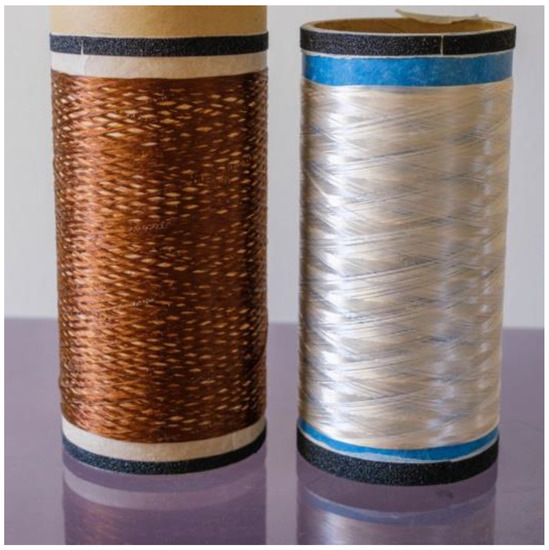
Figure 2.
Photograph of bobbins with precursors spun from dopes containing 30 wt% lignin and 70 wt% cellulose (left) or 100 wt% cellulose (right).
The precursor morphology with 0 and 30 wt% lignin from both systems was studied with SEM (Figure 3). The cross-sectional morphologies of the cellulose and cellulose/lignin (70/30 wt/wt) precursors coagulated in System S (Figure 3a,b) and System P (Figure 3c,d) varied significantly, but no effect of lignin was observed, supporting the view that cellulose is the fiber-forming polymer while lignin acts as a “filler” [37]. The precursors coagulated in System S had an irregular cross-section and pronounced striations in the longitudinal direction. The morphology of the fibers from System S agreed with earlier observations of cellulose fibers spun with the cold NaOH(aq) process and was similar to that of textile-grade viscose rayon [27,38]. In contrast, the precursors spun with System P had a circular cross-section and smoother fiber surface, resembling the appearance of air-gap-spun lyocell fibers as well as that of cellulose-lignin fibers derived from ionic liquids [24,39]. The various morphologies observed were probably related to the differences in coagulation rate of Systems S and P. Overall, the results suggest that the choice of coagulation conditions has a significant effect on fiber morphology, but the addition of lignin has no effect.
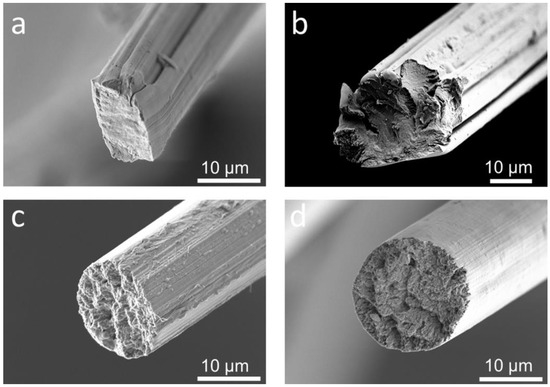
Figure 3.
SEM images of wet-spun cellulose precursors with (a) 0 wt% lignin in System S, (b) 30 wt% lignin in System S, (c) 0 wt% lignin in System P, and (d) 30 wt% lignin in System P.
3.1.2. Tensile Properties
The effect of lignin content on the tensile properties was studied on precursors spun from dopes containing up to 30 wt% lignin in Systems S and P (Figure 4). Regardless of the coagulation system, an increasing amount of lignin lowered the Young’s modulus and tenacity and increased the elongation at break. For precursors made with System S, an increase in lignin content from 0 to 30 wt% resulted in a lowering of the Young’s modulus from 1430 to 670 cN/tex, while the tenacity decreased from 26 to 12 cN/tex. The elongation at break increased from 4.9 to 6.6%. The effect of added lignin was weaker on precursors spun with System P than with System S. The decrease in tenacity and increase in break elongation with increasing lignin content has also been observed in cellulose-lignin fibers spun from ionic liquids, a behavior attributed to a “dilution” of the cellulose matrix [17,24]. The tenacity of 26 cN/tex for the neat cellulose precursor is on a par with that of a conditioned textile-grade viscose fiber, but the tenacity of 12 cN/tex observed for the fibers with 30% lignin is very low. A tenacity of 12 cN/tex (~180 MPa) is, however, significantly higher than the typical tensile strength of melt-spun lignin fibers used for CF preparation (20–40 MPa) [16,40], and it is thus sufficient for processing to CF.
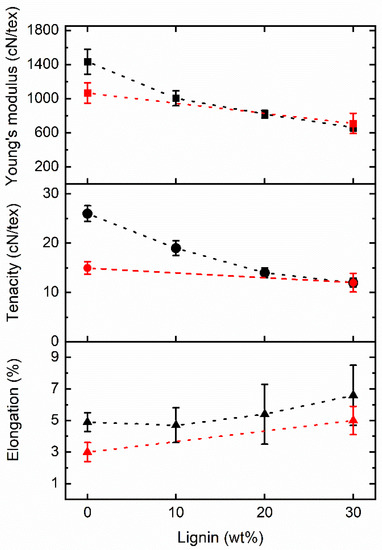
Figure 4.
Tensile properties of the precursors spun with Systems S (black) and P (red) vs. lignin content.
3.1.3. Precursor Structure
The precursors with 0 and 30 wt% lignin from the two systems were studied with WAXS using a commercial lyocell fiber as a reference. The 1D and 2D WAXS diffractograms are shown in Figures S1 and S3, respectively, with the fitting procedure and the characteristic reflections for cellulose II. The crystallinity and the degree of orientation calculated from WAXS are summarized in Table 3. In all cases, the presence of lignin reduced the crystallinity from about 40 to 30%. The crystallinity values were in the same range as those reported earlier for regenerated cellulose fibers prepared by the cold NaOH(aq) process as well as those for textile-grade viscose fibers [27,38]. A normalization of the crystallinity with respect to the cellulose content (70 wt%) of the lignin-containing precursors, gave a value of 40–43%, which closely resembled that of the precursors without lignin, supporting the idea that lignin “dilutes” the cellulose matrix [17,24]. The measured precursor orientation showed the same trend, where the precursors without lignin had the highest orientation (88–92%) regardless of the coagulation system used. As expected, the reference lyocell fibers had the highest crystallinity and orientation of about 45% and 96%, respectively. In general, a more crystalline and oriented precursor gave higher tensile properties, cf. Figure 4.

Table 3.
Degree of crystallinity (Xc) and degree of crystalline orientation (fc) of the precursors with 0 and 30 wt% lignin from Systems S and P.
3.1.4. Composition of Inorganic Elements in the Precursors
The residual inorganics in the precursors are important to study, particularly in System P, as they influence the thermal conversion to CF and the resulting CF quality. Therefore, the precursors with 0 and 30% lignin made with Systems S and P were analyzed with ICP-OES (Figure 5). As expected, the different coagulation systems resulted in significant differences in the elemental compositions of the precursors. The inorganics in the System S precursors consisted almost exclusively of Na and S, whereas those in the System P precursors were dominated by P. The residual Na in the System P fibers originated from Na present in the spin dope. The lignin-containing precursors had a higher amount of S than the precursors without lignin due to the S present in softwood kraft lignin [19]. Small amounts of Zn were detected in all samples, suggesting that not all the Zn was washed out of the fibers during wet spinning. For both systems, the total amount of inorganics was higher in the lignin-containing fibers, suggesting that a more extensive washing protocol may be necessary when wet spinning lignin-containing CF precursors. However, for System P it is desirable to have P in the precursors since it has a positive impact on the subsequent thermal conversion to CF. Optimization of the P content will be addressed in future work.
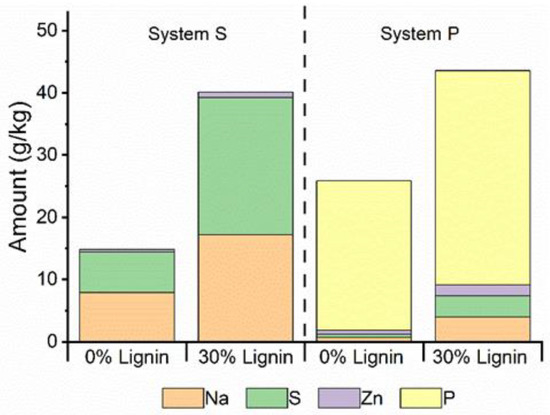
Figure 5.
Amounts of major inorganic elements (Na, S, Zn, and P) of the precursors spun with and without 30 wt% lignin in Systems S and P.
3.1.5. Thermal Properties
In CF preparation, the thermal properties of the precursor are important. The prime goal of adding lignin to cellulose as well as that of using System P instead of System S was to increase the conversion yield, and TGA in an inert atmosphere was therefore used to study the thermal behavior of the raw materials and the spun precursors (Figure 6). Figure 6a shows that the thermal degradation of the pulp and kraft lignin raw materials was in accordance with what is typically observed when pyrolyzing dissolving-grade pulp and softwood kraft lignin, respectively [19,24]. The char yield (defined here as the residual mass at 1000 °C) was 38 wt% for the lignin and 10 wt% for the cellulose pulp, showing that adding lignin to the cellulose had the potential to increase the conversion yield in CF preparation. The TGA curves of the spun precursors shown in Figure 6b indicate that the thermal behavior and char yield varied significantly. For System S precursors, a lower onset temperature of degradation was observed for the lignin-containing precursor, which was expected since lignin has a lower thermal stability than cellulose, as indicated in Figure 6a (Bengtsson et al., 2018). As expected, the same behavior was observed with System P. The ADHP in the System P precursors acts as a flame retardant, catalyzing the dehydration reactions during pyrolysis and leading to a higher char yield [23,41].
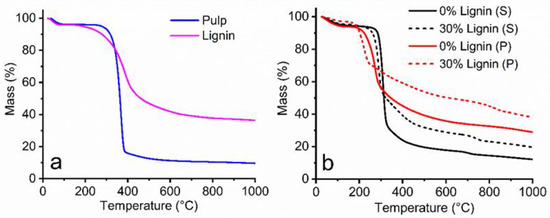
Figure 6.
TGA curves in a nitrogen atmosphere for (a) the softwood kraft lignin and pulp raw materials and (b) the precursors spun with 0 and 30 wt% lignin using Systems S and P.
In the case of precursors made with System S, the mass loss observed above 680 °C may be attributed to the thermal decomposition of residual ZnSO4, which is known to decompose at this temperature [42]. ZnSO4 was probably formed in the coagulation during wet spinning. A similar behavior was observed above 800 °C in the case of precursors made with System P, which was probably due to the removal of elemental P and CO because of an excess of residual salt [43,44,45]. This suggests a need to optimize the content of residual salt in the precursors.
All the precursors had a moisture content of 4–6 wt%. After correction for the moisture content, the precursors without lignin had char yields of 13 and 31 wt% for Systems S and P, respectively. The precursor with 30 wt% lignin (System S) had a char yield of 21 wt%, while the corresponding fiber made with System P had a yield of 39 wt%. This suggests that the presence of lignin and the use of System P had a beneficial impact, increasing the char yield. The effect of ADHP appears, however, to be greater than that of adding lignin. The precursors without lignin displayed more than a two-fold increase in char yield whereas the lignin-containing precursors displayed less than a two-fold increase, suggesting that the flame retardant effect of ADHP was greater in the former case.
3.2. CFs from Precursors Spun with System S
3.2.1. Tensile Properties
The precursors spun with 0, 10, and 30 wt% lignin in System S were converted batchwise to CF with a stabilization temperature of 250 °C and a final carbonization temperature of 1000 °C. For comparison with System P precursors, CFs were also prepared from the neat cellulose precursors using stabilization and carbonization temperatures of 275 °C and 1100 °C, respectively. The tensile properties of the CFs are shown in Figure 7. In all cases, the Young’s modulus and tensile strength were 54–77 GPa and 0.64–1.17 GPa, respectively, and the elongation at break was between 1.2 and 1.7%. The CFs made from the precursor containing 30 wt% lignin had the lowest tensile properties, but there was no significant difference between the CFs made from precursors containing 0 or 10 wt% lignin. The CF diameter from the latter precursors was, however, only 6–7 µm, whereas the CFs derived from the precursor with 30 wt% lignin had a diameter of about 13 µm. The smaller diameter reduces the risk of critical defects and is thus beneficial for a higher CF tensile strength [1,23,46]. Despite the low intrinsic viscosity (260 mL/g) of the cellulose pulp and the relatively low precursor tensile properties obtained with the cold NaOH(aq) process, the resultant CFs had tensile properties in the same range as those made from air-gap-spun cellulose-lignin precursors using ionic liquids and neat cellulosic rayon precursors [8,19]. The tensile properties were, however, lower than those recently reported for CFs from high-tenacity rayon and ionic liquid-based cellulose precursors prepared via a reduced-pressure stabilization method [47]. Vocht et al. (2022) used a stabilization method which made it possible to achieve cellulose-based CFs with higher tensile properties, and this non-conventional stabilization method should be explored for the precursors prepared in the present work.
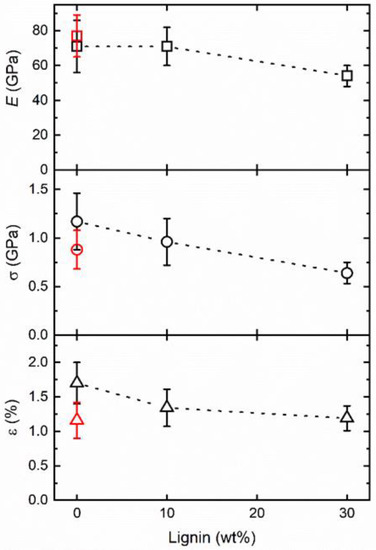
Figure 7.
Effect of lignin content in the System S precursors on the tensile properties of CFs made using batchwise conversion. Black: CFs derived with stabilization and carbonization profiles having final temperatures of 250 °C and 1000 °C, respectively. Red: CFs derived with stabilization and carbonization profiles having final temperatures of 275 °C and 1100 °C, respectively. E = Young’s modulus; σ = tensile strength; ε = elongation at break.
3.2.2. Gravimetric Yield
The gravimetric yield on conversion to CF influences the cost, and the yield was therefore determined by weighing CF tows before and after each step as shown in Figure 8. The conversion yield increased with increasing lignin content, showing that the addition of softwood kraft lignin had a positive impact on the yield, particularly at the higher lignin loading of 30 wt%. An increase in the yield relative to the theoretical carbon yield was also observed, suggesting that there is a synergistic effect when both cellulose and lignin are present [19,36]. These results support the earlier findings that the yield of cellulose-based CFs is higher when lignin is present in the precursor [19,21,24].
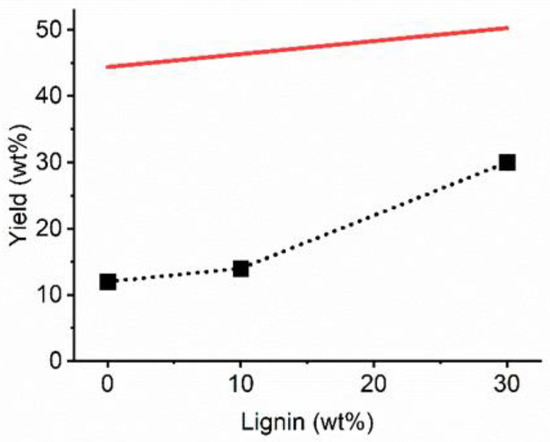
Figure 8.
The gravimetric CF yield after batchwise conversion as a function of lignin content in the System S precursor. The red line shows the theoretical carbon yield based on the carbon content of the raw materials.
The addition of lignin to the precursor led to a decrease in the stabilization yield from 98 to 88 wt% (see Table S1), indicating that the stabilization temperature used (250 °C) may have been too low, especially for the neat cellulose precursor, since our earlier work on CFs from air-gap-spun cellulose-lignin precursors (30/70 wt/wt) gave stabilization yields of about 85 wt% [23]. It is therefore suggested that a higher fraction of cellulose in the precursor requires a higher stabilization temperature than 250 °C.
Irrespective of the lignin content in the precursor, the carbon and oxygen contents of the CFs were 85–87 wt% and 12–14 wt%, respectively (Table S1). However, the CFs from the lignin-containing precursors also contained 0.5–1 wt% sulfur, originating from the sulfur present in the softwood kraft lignin [19].
3.2.3. Morphology
The morphologies of the CFs made from System S precursors with 0 and 30 wt% lignin were studied with SEM (Figure 9a,b). As in the precursors, the CF surfaces showed striations in the longitudinal direction of the fibers, suggesting that the morphology was preserved during the conversion process. Overall, the CFs displayed solid cross-sections regardless of the precursor used.
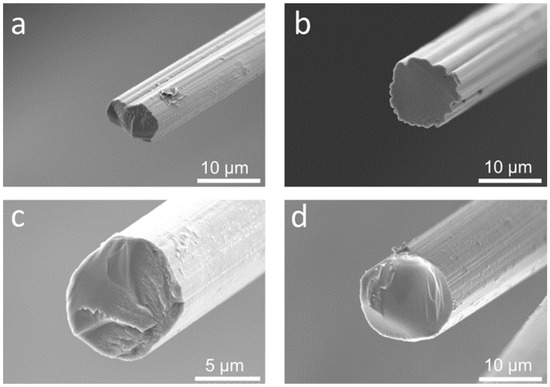
Figure 9.
SEM images of batchwise-derived CFs from precursors spun with System S containing (a) 0 wt% and (b) 30 wt% lignin and from precursors spun with System P containing (c) 0 wt% and (d) 30 wt% lignin.
3.3. CFs from Precursors Spun with System P
CFs derived from System P precursors were made both batchwise and via continuous conversion under more industrially relevant conditions such as residence time. Based on the results obtained with the System S precursors, the stabilization temperature was set to 275 °C, and the carbonization temperature was set to 1100 °C since a higher temperature reduces the residual phosphorus from biocarbons [45].
3.3.1. Morphology
The morphologies of batchwise-derived CFs made from precursors with 0 and 30 wt% lignin using System P are shown in Figure 9c,d. The CFs made using System P had a smoother surface and more circular cross-section than those made from System S precursors (Figure 9a,b). As with the CFs from System S, the precursor morphology of the System P fibers was preserved after conversion to CF. These results suggest that the CF morphology and appearance can be altered by using different coagulation conditions when choosing the cold NaOH(aq) process to prepare CF precursors.
3.3.2. Gravimetric Yield
The gravimetric yields of the CFs made from System P precursors are shown in Figure 10. The yield of the batchwise-derived CFs were 30 and 39 wt% for the neat cellulose and the lignin-containing precursor, respectively, but the CFs obtained via continuous conversion had an even higher yield (43–44 wt%), which was significantly higher than those obtained with System S. The yield of the CFs from System P was closer to the theoretical carbon yield (68–88%) than the System S fibers (27–60%), illustrating the flame retardant effect of ADHP (cf. Figure 8 and Figure 10). ADHP acts as a flame retardant by catalyzing the dehydration reactions during stabilization, and this in turn gives a higher yield in the subsequent carbonization (Table S1). The presence of ADHP in the cellulose precursor (about 2 wt% P, Figure 5) had the same effect on the yield as incorporating 30 wt% lignin in the precursors spun with System S. Figure 10 also shows that the batchwise-derived CFs also benefited from the combination of ADHP and lignin, although the effect was not as pronounced for the continuously derived samples, probably because of the substantial difference in total conversion time between the continuous (25 min) and batchwise (432 min) processes. The elemental composition of the CFs was analyzed (Table S1). Irrespective of conversion mode and lignin content, the resultant CFs had similar carbon (90 wt%) and oxygen (7 wt%) contents, and 2–3 wt% P was also detected, which is in agreement with earlier observations [23]. These results indicated that the use of lignin and System P in precursor spinning was beneficial for the CF yield.

Figure 10.
Gravimetric CF yield of System P precursors containing 0 or 30 wt% lignin using batchwise and continuous conversion.
3.3.3. Tensile Properties
The CFs derived via batchwise conversion using the System P precursors with 0 and 30 wt% lignin had almost identical Young’s moduli and tensile strengths of 53–55 GPa and 0.65–0.69 GPa, respectively (Table S2), indicating that the addition of 30 wt% lignin was not detrimental to the final CF properties. The tensile properties of the CFs derived from the lignin-containing precursor were similar to those of the corresponding System S fibers, but the CFs from the neat cellulose precursor had significantly lower tensile properties (cf. Figure 7), which is in agreement with the observed differences in precursor tensile properties (Figure 4) and crystalline orientation (Table 3). A high precursor orientation evidently enhanced its tensile properties, and these were transferred to the final CF. The lower tensile properties of the CFs from System P fibers may be due to the residual P (~2 wt%) found in the CFs (Table S1). A similar observation has been reported for CFs made from ionic liquid-based cellulose-lignin precursors impregnated with ADHP [23].
The System P precursors were also processed to CFs via continuous conversion using different fiber tensions in the carbonization step. In these experiments, emphasis was put on the neat cellulose precursor, but the lignin-containing precursor was also converted to a CF, and their tensile properties are shown as functions of fiber tensions in Figure 11. In all cases, a low tension of 0.2 cN/tex gave low tensile properties. For the cellulose precursor, an increase in tension from 0.2 to 1.3 cN/tex increased the Young’s modulus by 31% from 35 to 46 GPa. A higher tension gave no great increase in tensile strength, probably because the CF tensile strength is governed by defects such as voids [46]. This was supported by the finding that the diameters and tensile strengths of the CFs made via batchwise and continuous conversion were the same, but a higher Young’s modulus (53–55 GPa) was obtained for the batchwise-derived CFs. The batchwise-derived CFs were mounted on a graphite frame to prevent shrinkage (relative stretch = 0%) during conversion, and the tension applied during these trials is not known. In the continuous conversion trials, however, there was a negative relative stretch of a few percent (fiber contraction). It thus appears that the tension applied during carbonization has an important effect on the Young’s modulus.
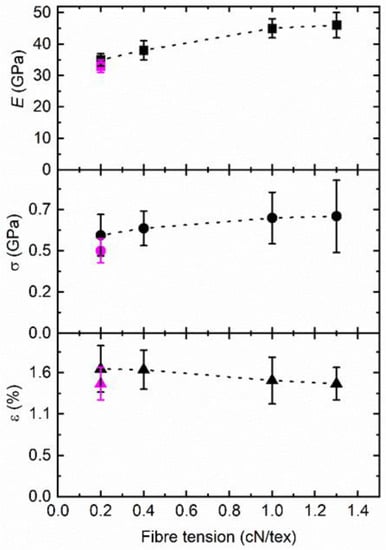
Figure 11.
Effect of fiber tension during carbonization on the tensile properties of CFs made by continuous conversion of System P precursors. Black: 0 wt% lignin; purple: 30 wt% lignin. For all samples, a residence time of 10 min was used except when using a tension of 1.3 cN/tex, where 20 min was used. E = Young’s modulus; σ = tensile strength; ε = elongation at break.
The residence time during carbonization affected the maximum possible tension. A tension up to 1.0 cN/tex could be applied when using a residence time of 10 min, but a tension of 1.3 cN/tex required a time of 20 min. This agreed well with the observations of Spörl et al. (2017) [41], who studied the continuous carbonization of viscose fibers impregnated with ADHP. In the present work, a two-stage conversion protocol was used, which included continuous stabilization up to 275 °C for 15 min followed by continuous carbonization at 1100 °C for 10 or 20 min. In addition to improving the conversion protocol, improved quality of the precursors will also be advantageous.
3.3.4. Structure of CFs
The CF structure was investigated by both WAXS and Raman spectroscopy on selected CFs having different Young’s moduli. Table 4 summarizes the data obtained by WAXS measurements. The 2D diffraction patterns are shown in Figure S4, and integrated 1D WAXS profiles are shown in Figure S5. In carbon materials with a graphite-like structure, the crystallite is characterized by its dimensions along (La) and perpendicular (Lc) to the graphene layers, respectively, and d002 is the interlayer spacing between individual graphene layers. A defect-free graphite crystal has a d002 value of 0.335 nm, but CFs often display values between 0.34 and 0.39 nm depending on the precursor and the final carbonization temperature used [48,49,50]. Table 4 presents a summary of the structural parameters of the cellulose-lignin-derived CFs including the orientation of the (002) plane. The WAXS measurements revealed that the CFs had relatively similar crystal dimensions. However, all the CFs displayed a stack height (Lc) below 2 nm except for the sample with the highest Young’s modulus (77 GPa). In contrast, the CF with the highest modulus displayed the lowest La, which may indicate that this CF had a slightly different carbon structure. This sample contained no residual P since System S was used in the precursor spinning. It was suggested by Spörl et al. (2017). [41] that residual P in cellulose-based CFs may accumulate between the carbon layers rather than being incorporated in them and that this interferes with the layer stacking (Lc) and promotes growth in the in-plane direction La. The results in the present work support this hypothesis and further suggest that optimization of the P content in the precursors and in the final CF is necessary.

Table 4.
Structural parameters and orientation from WAXS of CFs prepared by batchwise and continuous conversion. L = Lignin; S = System S; P = System P.
The preferred relative orientation (fc) of the (002) plane varied among the samples and was related to the Young’s modulus of the CFs since a higher orientation gave a CF with a higher modulus. For the continuously derived CFs, an increase in tension from 0.2 to 1.3 cN/tex increased the orientation by about 7%, giving an increase in modulus of about 30%.
To gain further insight into the carbon structure of the CFs, the same samples were characterized with Raman spectroscopy, which is a versatile tool for studying the structure of carbon-based materials [51]. All the CFs displayed two major bands centered at 1339 and 1588 cm−1, identified as the D (D1) and G bands, respectively (Figure S6). Three other bands (D2, D3, and D4) commonly seen in disordered carbons such as turbostratic graphite [50] were also found. The G band arises from the in-plane bond stretching modes of sp2-bonded carbon (E2g symmetry), while the D band originates from the breathing mode of A1g symmetry in a graphite layer [51]. The latter originates in the vicinity of a defect or border where an sp2-bonded carbon in the hexagonal lattice is replaced by an sp3 bond. To elucidate the structural order of the CFs, the ratio of the D to the G band can be used. Whether the intensity or the areal ratio should be used is debatable, however [51,52].
The Raman measurements revealed that the CFs with the highest Young’s modulus (batchwise-derived) had the fewest defects, as suggested by their higher intensity ratio (ID/IG) (see Table 5). According to Ferrari’s famous three-stage model, a higher ID/IG of disordered carbons prepared in the temperature range used here (1100 °C, stage II) corresponds to a structure with more nanocrystalline graphite and less amorphous carbon than a material with a lower ID/IG [51]. If, on the other hand, the areal ratio (AD/AG) is used, the opposite trend is observed, and the CFs with the highest Young’s modulus have the lowest ratios (data not shown), which suggests that the CFs with the highest Young’s modulus have a less disordered carbon structure.

Table 5.
Intensity ratio of D to G bands from Raman measurements on CFs prepared by batchwise and continuous conversion. L = Lignin; S = System S; P = System P.
4. Conclusions
For the first time, CFs were prepared from wet-spun cellulose-lignin precursors using an aqueous cold NaOH(aq) process for direct co-dissolution of dissolving-grade pulp and softwood kraft lignin. Precursors were spun from dopes with up to 30 wt% lignin using two different coagulation baths: one with H2SO4/Na2SO4 (System S) and one with H3PO4/NH4H2PO4 (System P). The latter gives the precursors flame-retardant properties. The precursor tenacity was in the 11–26 cN/tex range, where an increasing amount of lignin in the precursor reduced the tenacity. The precursor morphology was affected by the coagulation bath used: System S gave precursors with a striated surface and irregular cross-section, while System P gave fibers with a smoother surface and a circular cross-section.
The precursors were processed to CFs by batchwise and continuous conversion using a final temperature of 1000–1100 °C. No change in morphology after conversion was observed, indicating that the precursor morphology is transferred to the CF. The gravimetric yield and tensile properties were strongly affected by the choice of precursor and conversion conditions. The yield varied between 12 and 44 wt%, where the addition of lignin and/or the use of System P resulted in a significant increase in yield. The CFs had a Young’s modulus and tensile strength of 33–77 GPa and 0.48–1.17 GPa, respectively, and the batchwise-derived CFs displayed the highest values. Structural characterization of the precursors and the resultant CFs showed that a higher precursor crystallinity and greater orientation correlated with fewer defects and higher tensile properties of the CF.
The continuous conversion trials demonstrated the importance of tension control. A higher tension resulted in an increase in Young’s modulus of about 30%. Further work should focus on optimization of the continuous conversion procedure.
5. Patents
On behalf of RISE Research Institutes of Sweden AB, the authors A.B., A.L., E.B., and M.S. have made a patent application related to carbon fibers from wet-spun cellulose-lignin precursors using the cold alkali process. SE 2050820 A1 Method of wet spinning precursor fibers comprising lignin and dissolving pulp and precursor fibers therefrom (filed 2020-07-01).
Supplementary Materials
The following supporting information can be downloaded at: https://www.mdpi.com/article/10.3390/fib10120108/s1, Figure S1: 1D WAXS figures of precursors incl. signal assignment, Figure S2: Fitting procedure of Raman spectra, Figure S3: 2D WAXS scattering pattern of precursors, Figure S4: 2D WAXS scattering patterns of CFs, Figure S5: 1D WAXS figures of CFs incl. fitting procedure, Figure S6: Raman spectra of CFs; Table S1: Gravimetric yield and elemental composition of CFs, Table S2: A summary of the tensile properties of the CFs.
Author Contributions
Investigation and conceptualization, A.B., A.L., L.N., S.Y. and M.S.; Methodology: A.B., S.Y. and M.S.; Visualization: A.B.; Writing: A.B.; Writing—review and editing: A.B., M.S., E.B., S.Y. and M.E. Supervision M.S., E.B. and M.E. All authors have read and agreed to the published version of the manuscript.
Funding
This research received no external funding except the assistance with the Raman and WAXS analyzes, which were funded by Treesearch. Shun Yu acknowledges the Swedish Research Council VR (grant No. 2018-06378) for financial support to assist in the dissemination of the WAXS results.
Data Availability Statement
All data created in this study are presented in this paper.
Acknowledgments
The authors express their gratitude to Treesearch and Anita Teleman (RISE AB) as well as to Nataliia Mozhzhukhina (Chalmers University of Technology) for providing support with the WAXS and Raman analyzes, respectively. Shun Yu acknowledges the Swedish Research Council VR (grant No. 2018-06378) for financial support.
Conflicts of Interest
The authors declare no conflict of interest.
References
- Bahl, O.; Shen, Z.; Lavin, J.G.; Ross, R.A. Manufacture of Carbon Fibers. In Carbon Fibers; Donnet, J.-B., Wang, T.K., Peng, J.C.M., Rebouillat, S., Eds.; Marcel Dekker Inc.: New York, NY, USA, 1998; Volume 3, pp. 1–85. [Google Scholar]
- Huang, X. Fabrication and Properties of Carbon Fibers. Materials 2009, 2, 2369–2403. [Google Scholar] [CrossRef]
- Newcomb, B.A. Processing, structure, and properties of carbon fibers. Compos. Part A Appl. Sci. Manuf. 2016, 91, 262–282. [Google Scholar] [CrossRef]
- Composites World. Carbon Fiber 2014 Conference Report. Available online: https://www.compositesworld.com/articles/carbon-fiber-2014-conference-report (accessed on 14 November 2018).
- Kadla, J.; Kubo, S.; Venditti, R.; Gilbert, R.; Compere, A.; Griffith, W. Lignin-based carbon fibers for composite fiber applications. Carbon 2002, 40, 2913–2920. [Google Scholar] [CrossRef]
- Gellerstedt, G. Softwood kraft lignin: Raw material for the future. Ind. Crop Prod. 2015, 77, 845–854. [Google Scholar] [CrossRef]
- Morgan, P. Carbon Fibers and Their Composites, 1st ed.; CRC Press: Boca Raton, FL, USA, 2005. [Google Scholar] [CrossRef]
- Dumanlı, A.G.; Windle, A.H. Carbon fibres from cellulosic precursors: A review. J. Mater. Sci. 2012, 47, 4236–4250. [Google Scholar] [CrossRef]
- Baker, D.A.; Rials, T.G. Recent advances in low-cost carbon fiber manufacture from lignin. J. Appl. Polym. Sci. 2013, 130, 713–728. [Google Scholar] [CrossRef]
- Braun, J.; Holtman, K.; Kadla, J. Lignin-based carbon fibers: Oxidative thermostabilization of kraft lignin. Carbon 2005, 43, 385–394. [Google Scholar] [CrossRef]
- Baker, D.A.; Gallego, N.C.; Baker, F.S. On the characterization and spinning of an organic-purified lignin toward the manufacture of low-cost carbon fiber. J. Appl. Polym. Sci. 2012, 124, 227–234. [Google Scholar] [CrossRef]
- Uraki, Y.; Kubo, S.; Nigo, N.; Sano, Y.; Sasaya, T. Preparation of Carbon Fibers from Organosolv Lignin Obtained by Aqueous Acetic Acid Pulping. Holzforschung 1995, 49, 343–350. [Google Scholar] [CrossRef]
- Mainka, H.; Hilfert, L.; Busse, S.; Edelmann, F.; Haak, E.; Herrmann, A.S. Characterization of the major reactions during conversion of lignin to carbon fiber. J. Mater. Res. Technol. 2015, 4, 377–391. [Google Scholar] [CrossRef]
- Norberg, I.; Nordström, Y.; Drougge, R.; Gellerstedt, G.; Sjöholm, E. A new method for stabilizing softwood kraft lignin fibers for carbon fiber production. J. Appl. Polym. Sci. 2012, 128, 3824–3830. [Google Scholar] [CrossRef]
- Nordström, Y.; Norberg, I.; Sjöholm, E.; Drougge, R. A new softening agent for melt spinning of softwood kraft lignin. J. Appl. Polym. Sci. 2012, 129, 1274–1279. [Google Scholar] [CrossRef]
- Kleinhans, H.; Salmén, L. Development of lignin carbon fibers: Evaluation of the carbonization process. J. Appl. Polym. Sci. 2016, 133, 43965. [Google Scholar] [CrossRef]
- Ma, Y.; Asaadi, S.; Johansson, L.-S.; Ahvenainen, P.; Reza, M.; Alekhina, M.; Rautkari, A.-P.L.; Michud, A.; Hauru, L.; Hummel, M.; et al. High-Strength Composite Fibers from Cellulose-Lignin Blends Regenerated from Ionic Liquid Solution. ChemSusChem 2015, 8, 4030–4039. [Google Scholar] [CrossRef]
- Olsson, C.; Sjöholm, E.; Reimann, A. Carbon fibres from precursors produced by dry-jet wet-spinning of kraft lignin blended with kraft pulps. Holzforschung 2017, 71, 275–283. [Google Scholar] [CrossRef]
- Bengtsson, A.; Bengtsson, J.; Olsson, C.; Sedin, M.; Jedvert, K.; Theliander, H.; Sjöholm, E. Improved yield of carbon fibres from cellulose and kraft lignin. Holzforschung 2018, 72, 1007–1016. [Google Scholar] [CrossRef]
- Svenningsson, L.; Bengtsson, J.; Jedvert, K.; Schlemmer, W.; Theliander, H.; Evenäs, L. Disassociated molecular orientation distributions of a composite cellulose–lignin carbon fiber precursor: A study by rotor synchronized NMR spectroscopy and X-ray scattering. Carbohydr. Polym. 2020, 254, 117293. [Google Scholar] [CrossRef]
- Vincent, S.R.; Prado, R.; Kuzmina, O.; Potter, K.; Bhardwaj, J.; Wanasekara, N.D.; Harniman, R.L.; Koutsomitopoulou, A.; Eichhorn, S.J.; Welton, T.; et al. Regenerated Cellulose and Willow Lignin Blends as Potential Renewable Precursors for Carbon Fibers. ACS Sustain. Chem. Eng. 2018, 6, 5903–5910. [Google Scholar] [CrossRef]
- Byrne, N.; De Silva, R.; Ma, Y.; Sixta, H.; Hummel, M. Enhanced stabilization of cellulose-lignin hybrid filaments for carbon fiber production. Cellulose 2017, 25, 723–733. [Google Scholar] [CrossRef]
- Bengtsson, A.; Bengtsson, J.; Sedin, M.; Sjöholm, E. Carbon Fibers from Lignin-Cellulose Precursors: Effect of Stabilization Conditions. ACS Sustain. Chem. Eng. 2019, 7, 8440–8448. [Google Scholar] [CrossRef]
- Trogen, M.; Le, N.-D.; Sawada, D.; Guizani, C.; Lourençon, T.V.; Pitkänen, L.; Sixta, H.; Shah, R.; O’Neill, H.; Balakshin, M.; et al. Cellulose-lignin composite fibres as precursors for carbon fibres. Part 1—Manufacturing and properties of precursor fibres. Carbohydr. Polym. 2020, 252, 117133. [Google Scholar] [CrossRef] [PubMed]
- Mai, N.L.; Ahn, K.; Koo, Y.-M. Methods for recovery of ionic liquids—A review. Process Biochem. 2014, 49, 872–881. [Google Scholar] [CrossRef]
- Määttänen, M.; Gunnarsson, M.; Wedin, H.; Stibing, S.; Olsson, C.; Köhnke, T.; Asikainen, S.; Vehviläinen, M.; Harlin, A. Pre-treatments of pre-consumer cotton-based textile waste for production of textile fibres in the cold NaOH(aq) and cellulose carbamate processes. Cellulose 2021, 28, 3869–3886. [Google Scholar] [CrossRef]
- Vehviläinen, M.; Kamppuri, T.; Rom, M.; Janicki, J.; Ciechańska, D.; Grönqvist, S.; Siika-Aho, M.; Christoffersson, K.E.; Nousiainen, P. Effect of wet spinning parameters on the properties of novel cellulosic fibres. Cellulose 2008, 15, 671–680. [Google Scholar] [CrossRef]
- Brännvall, E.; Walter, K. Process modifications to obtain a prehydrolysis kraft dissolving pulp with low limiting pulp viscosity. Nord. Pulp Pap. Res. J. 2020, 35, 332–341. [Google Scholar] [CrossRef]
- Bengtsson, A.; Bengtsson, J.; Jedvert, K.; Kakkonen, M.; Tanhuanpää, O.; Brännvall, E.; Sedin, M. Continuous Stabilization and Carbonization of a Lignin–Cellulose Precursor to Carbon Fiber. ACS Omega 2022, 7, 16793–16802. [Google Scholar] [CrossRef]
- Langan, P.; Nishiyama, A.Y.; Chanzy, H. X-ray Structure of Mercerized Cellulose II at 1 Å Resolution. Biomacromolecules 2001, 2, 410–416. [Google Scholar] [CrossRef]
- French, A.D. Idealized powder diffraction patterns for cellulose polymorphs. Cellulose 2013, 21, 885–896. [Google Scholar] [CrossRef]
- Costa, C.; Medronho, B.; Eivazi, A.; Svanedal, I.; Lindman, B.; Edlund, H.; Norgren, M. Lignin enhances cellulose dissolution in cold alkali. Carbohydr. Polym. 2021, 274, 118661. [Google Scholar] [CrossRef]
- Mao, Y.; Zhang, L.; Cai, J.; Zhou, J.; Kondo, T. Effects of Coagulation Conditions on Properties of Multifilament Fibers Based on Dissolution of Cellulose in NaOH/Urea Aqueous Solution. Ind. Eng. Chem. Res. 2008, 47, 8676–8683. [Google Scholar] [CrossRef]
- Budtova, T.; Navard, P. Cellulose in NaOH–water based solvents: A review. Cellulose 2015, 23, 5–55. [Google Scholar] [CrossRef]
- Hagman, J.; Gentile, L.; Jessen, C.M.; Behrens, M.; Bergqvist, K.-E.; Olsson, U. On the dissolution state of cellulose in cold alkali solutions. Cellulose 2017, 24, 2003–2015. [Google Scholar] [CrossRef]
- Le, N.-D.; Trogen, M.; Varley, R.J.; Hummel, M.; Byrne, N. Chemically Accelerated Stabilization of a Cellulose–Lignin Precursor as a Route to High Yield Carbon Fiber Production. Biomacromolecules 2022, 23, 839–846. [Google Scholar] [CrossRef]
- Protz, R.; Lehmann, A.; Ganster, J.; Fink, H.-P. Solubility and spinnability of cellulose-lignin blends in aqueous NMMO. Carbohydr. Polym. 2020, 251, 117027. [Google Scholar] [CrossRef]
- Yang, Y.; Zhang, Y.; Dawelbeit, A.; Deng, Y.; Lang, Y.; Yu, M. Structure and properties of regenerated cellulose fibers from aqueous NaOH/thiourea/urea solution. Cellulose 2017, 24, 4123–4137. [Google Scholar] [CrossRef]
- Cui, S.; Zhang, Y.; Liu, C.; Lou, S.; Zhang, Y.; Wang, H. The influence of the multi-level structure under high drawing on the preparation of high strength Lyocell fiber. Cellulose 2022, 29, 751–762. [Google Scholar] [CrossRef]
- Enengl, C.; Lone, S.A.; Unterweger, C.; Fürst, C. Screening of spinning oils for melt-spun lignin-based carbon fiber precursors. J. Appl. Polym. Sci. 2022, 139, 52134. [Google Scholar] [CrossRef]
- Spörl, J.M.; Beyer, R.; Abels, F.; Cwik, T.; Müller, A.; Hermanutz, F.; Buchmeiser, M.R. Cellulose-Derived Carbon Fibers with Improved Carbon Yield and Mechanical Properties. Macromol. Mater. Eng. 2017, 302, 1700195. [Google Scholar] [CrossRef]
- Jones, F.; Tran, H.; Lindberg, D.; Zhao, L.; Hupa, M. Thermal Stability of Zinc Compounds. Energy Fuels 2013, 27, 5663–5669. [Google Scholar] [CrossRef]
- Puziy, A.M.; Poddubnaya, O.I.; Martínez-Alonso, A.; Suárez-García, F.; Tascón, J.M. Surface chemistry of phosphorus-containing carbons of lignocellulosic origin. Carbon 2005, 43, 2857–2868. [Google Scholar] [CrossRef]
- Chen, X.; Wu, H. Transformation and release of phosphorus during rice bran pyrolysis: Effect of reactor configurations under various conditions. Fuel 2019, 255, 115755. [Google Scholar] [CrossRef]
- Olsson, E.O.L.; Glarborg, P.; Leion, H.; Dam-Johansen, K.; Wu, H. Release of P from Pyrolysis, Combustion, and Gasification of Biomass—A Model Compound Study. Energy Fuels 2021, 35, 15817–15830. [Google Scholar] [CrossRef]
- Kong, L.; Liu, H.; Cao, W.; Xu, L. PAN fiber diameter effect on the structure of PAN-based carbon fibers. Fibers Polym. 2014, 15, 2480–2488. [Google Scholar] [CrossRef]
- Vocht, M.P.; Ota, A.; Frank, E.; Hermanutz, F.; Buchmeiser, M.R. Preparation of Cellulose-Derived Carbon Fibers Using a New Reduced-Pressure Stabilization Method. Ind. Eng. Chem. Res. 2022, 61, 5191–5201. [Google Scholar] [CrossRef]
- Belenkov, E. Formation of Graphite Structure in Carbon Crystallites. Inorg. Mater. 2001, 37, 928–934. [Google Scholar] [CrossRef]
- Sagues, W.; Jain, A.; Brown, D.; Aggarwal, S.; Suarez, A.; Kollman, M.; Park, S.; Argyropoulos, D.S. Are lignin-derived carbon fibers graphitic enough? Green Chem. 2019, 21, 4253–4265. [Google Scholar] [CrossRef]
- Breitenbach, S.; Unterweger, C.; Lumetzberger, A.; Duchoslav, J.; Stifter, D.; Hassel, A.W.; Fürst, C. Viscose-based porous carbon fibers: Improving yield and porosity through optimization of the carbonization process by design of experiment. J. Porous Mater. 2021, 28, 727–739. [Google Scholar] [CrossRef]
- Ferrari, A.C.; Robertson, J. Interpretation of Raman spectra of disordered and amorphous carbon. Phys. Rev. B 2000, 61, 14095–14107. [Google Scholar] [CrossRef]
- Moon, H.; Zarrabeitia, M.; Frank, E.; Böse, O.; Enterría, M.; Saurel, D.; Hasa, I.; Passerini, S. Assessing the Reactivity of Hard Carbon Anodes: Linking Material Properties with Electrochemical Response Upon Sodium- and Lithium-Ion Storage. Batter. Supercaps 2021, 4, 960–977. [Google Scholar] [CrossRef]
Publisher’s Note: MDPI stays neutral with regard to jurisdictional claims in published maps and institutional affiliations. |
© 2022 by the authors. Licensee MDPI, Basel, Switzerland. This article is an open access article distributed under the terms and conditions of the Creative Commons Attribution (CC BY) license (https://creativecommons.org/licenses/by/4.0/).